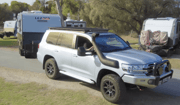Fire service issues urgent warning after rise in lithium-ion battery fires
By
- Replies 10
In recent years, we've seen a technological revolution that has brought countless conveniences into our lives.
The lithium-ion battery powers many devices, from smartphones to electric scooters.
However, alongside these technological advancements, South Australia is grappling with a significant issue that demands attention and action.
The South Australian Metropolitan Fire Service (MFS) has issued an urgent warning after a staggering 650 per cent increase in fire callouts involving these batteries over the past five years.
From a mere four incidents to a concerning 30, the trend is not only alarming but expected to worsen.
In 2024 alone, there have already been 13 callouts, with mobility devices, portable batteries, and tools being the most common culprits.
The risk may not be entirely eliminated, but MFS Deputy Chief Officer Jeff Swann advised taking specific precautions to ensure safety.
‘Always store them and use them as per manufacturer instructions. Use the correct battery and the correct charger for the device,’ Swann advised.
The state’s Minister for Consumer and Business Affairs, Andrea Michaels, has personal experience with their inherent risks.
‘I had a fire at my house in 2020, charging an electric hoverboard overnight, which caused a fire at my house which was devastating,’ Michaels said.
Just ten days ago, a vacuum cleaner battery left charging, led to a house fire in Angle Vale, and last month, a faulty scooter battery caused a warehouse fire in the city.
Even high-rise buildings were not immune, as evidenced by a battery explosion on the 12th floor in April.
So, what can you do to protect your home and loved ones from these hidden threats?
To prevent lithium-ion battery fires, it's crucial to disconnect devices once they're fully charged and always charge batteries on non-combustible surfaces.
Use compatible chargers and avoid mixing brands: purchase replacement batteries and chargers from reputable sources.
Regularly inspect batteries for damage, such as cracks, dents, swelling, leaks, overheating, or smoke.
Dispose of damaged or used batteries at designated recycling drop-off points and ensure rooms, where batteries are stored have working smoke alarms installed.
These steps help mitigate risks associated with lithium-ion batteries.
Following these precautions can significantly reduce the risk of a lithium-ion battery fire in your home.
Similarly, the Australian Competition and Consumer Commission (ACCC) warned consumers about the risk of fires from these batteries.
They estimated over 89,000 product recalls due to fire risk or overheating. You can read more information here.

What precautions have you taken to safeguard your home against potential fires? Share your thoughts and opinions in the comments below!
The lithium-ion battery powers many devices, from smartphones to electric scooters.
However, alongside these technological advancements, South Australia is grappling with a significant issue that demands attention and action.
The South Australian Metropolitan Fire Service (MFS) has issued an urgent warning after a staggering 650 per cent increase in fire callouts involving these batteries over the past five years.
From a mere four incidents to a concerning 30, the trend is not only alarming but expected to worsen.
In 2024 alone, there have already been 13 callouts, with mobility devices, portable batteries, and tools being the most common culprits.
The risk may not be entirely eliminated, but MFS Deputy Chief Officer Jeff Swann advised taking specific precautions to ensure safety.
‘Always store them and use them as per manufacturer instructions. Use the correct battery and the correct charger for the device,’ Swann advised.
The state’s Minister for Consumer and Business Affairs, Andrea Michaels, has personal experience with their inherent risks.
‘I had a fire at my house in 2020, charging an electric hoverboard overnight, which caused a fire at my house which was devastating,’ Michaels said.
Just ten days ago, a vacuum cleaner battery left charging, led to a house fire in Angle Vale, and last month, a faulty scooter battery caused a warehouse fire in the city.
Even high-rise buildings were not immune, as evidenced by a battery explosion on the 12th floor in April.
So, what can you do to protect your home and loved ones from these hidden threats?
To prevent lithium-ion battery fires, it's crucial to disconnect devices once they're fully charged and always charge batteries on non-combustible surfaces.
Use compatible chargers and avoid mixing brands: purchase replacement batteries and chargers from reputable sources.
Regularly inspect batteries for damage, such as cracks, dents, swelling, leaks, overheating, or smoke.
Dispose of damaged or used batteries at designated recycling drop-off points and ensure rooms, where batteries are stored have working smoke alarms installed.
These steps help mitigate risks associated with lithium-ion batteries.
Following these precautions can significantly reduce the risk of a lithium-ion battery fire in your home.
Similarly, the Australian Competition and Consumer Commission (ACCC) warned consumers about the risk of fires from these batteries.
They estimated over 89,000 product recalls due to fire risk or overheating. You can read more information here.
Key Takeaways
- There's been an increase in lithium-ion battery fires in South Australia, with a 650 per cent jump in fire callouts over the past five years.
- The Metropolitan Fire Service warned against leaving batteries charging overnight unattended due to their unpredictable nature.
- The most common causes of these fires were related to mobility devices, portable batteries, and tools.
- The MFS and Consumer and Business Services provide safety tips to prevent battery fires, such as wanting individuals to charge batteries on non-combustible surfaces and to use compatible chargers.
Last edited by a moderator:








